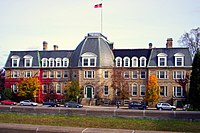Higher education in New Brunswick
[1] Mount Allison University was the first in the British Empire to award a baccalaureate to a woman, Grace Annie Lockhart, B.Sc.
The Department provides a major portion of post-secondary revenue, but universities and colleges alike remain relatively independent in their governance structures.
Loyalists who settled in Nova Scotia who had been involved with American higher education, most notably Charles Inglis of King's College, New York; Benjamin Moore; and Jonathan Odell, drew up a plan for the future education of their sons in Nova Scotia.
[15] In June 1839, Charles Allison proposed to the Wesleyan Methodists that a school of elementary and higher learning be built.
[17] Mount Allison Wesleyan College was established in 1862 with degree-granting powers on behalf of the other Academies and the first two students, Howard Sprague and Josiah Wood, graduated in May 1863.
[18] Mount Allison was the first university in the British Empire to confer a bachelor's degree to a woman in 1875, (Grace Annie Lockhart, B.Sc.
At the Charlottetown Conference in 1864, representatives from the British North America colonies - Nova Scotia, New Brunswick, Prince Edward Island and the Province of Canada - gathered to discuss Confederation.
To avoid duplicate services, the two universities share each other's libraries and St. Thomas students have access to UNB's scientific, cultural, and athletic facilities.
[29] In 1973, the New Brunswick Community College (NBCC) was established with a mandate to provide post-secondary non-university education throughout the Province.
In the 1950s after World War II it reopened a summer program; in the 1960s it was called The Crafts School; and in 2007 it was transformed into a comprehensive college offering diplomas and the Bachelor of Applied Arts degree.
The objective of the College is to produce competent forest technologists for service with private, industrial or public (government) forestry or natural resource organizations.
[38] The Act provides for evaluation of the quality of programs that lead to a degree offered by all public and private institutions in New Brunswick.
[42] Ratified by the Council of Maritime Premiers, the act defined the mandate of the Commission as both improving and providing the best possible service to students as lifelong learners in the provinces of New Brunswick, Nova Scotia and Prince Edward Island.
[50] Private sector programs that are considered enhance employment in some form must register programs/courses and instructors in accordance with the Act and its Regulation.
Examples of training at post-secondary levels include Dental Assisting, Massage therapy, Truck Driving, Cosmetology, Travel & Tourism, Business Education and Computer related programs.
One of the fundamental roles of the association is to create greater awareness and understanding of the important contribution of universities to the social and economic development of the Atlantic Provinces.
The activities of the Association are funded principally through annual membership fees based on the operating income of the member institutions.
[55] The presidents of the universities and colleges of Canada represent their institutions in this association, sharing information and promoting the interests of Canadian higher education.
20 post-secondary institutions across Canada are members, including Université de Moncton and Collège communautaire du Nouveau-Brunswick.
[58] The Atlantic ministers responsible for education and training signed an agreement in April 2004 under which the provinces of New Brunswick, Newfoundland and Labrador, Nova Scotia, and Prince Edward Island agreed to collaborate on joint undertakings to respond to the needs identified in public and post-secondary education.
CAMET is dedicated to further enhancing the level of cooperation in public and post-secondary education by working on common issues to improve learning for all Atlantic Canadians, optimize efficiencies and bring added value to provincial initiatives and priorities.
[59] The MPHEC was created in 1974 to assist Prince Edward Island, New Brunswick and Nova Scotia and their institutions in attaining a more efficient and effective utilization and allocation of higher education resources.
It provides quality assurance, data and information sharing, cooperative action, and regional programmes as well as specific services to one or more provinces or institutions as agreed to by the Ministers of Education.
[62] The domestic tuition at New Brunswick Community College and Collège Communautair du Nouveau-Brunswick for 2011-12 is $3,000 per year plus fees.
While participation rates were higher than the national average, the population of 18- to 24-year-olds in NB and the rest of the Maritime provinces were predicted to decline greater than the rest of Canada; undergraduate participation peaked in New Brunswick in 2003/04 and in Prince Edward Island and Nova Scotia during the 2004/05 academic session.
The New Brunswick Community College (NBCC) has had a "policy in place since 1994 to allow, where academically appropriate, credit transferability of courses, programs, or units of instruction that have been taken at approved public and private postsecondary institutions.
[71] The Canada Millennium Scholarship Foundation was established in 1998 to provide support to students with demonstrated financial need.
Students must have been enrolled full-time in undergraduate studies that lead to a degree, certificate or diploma in a program of at least two years in length.
One private degree-granting institution operates completely online and there is substantial focus on the development of Internet-based postsecondary education.



